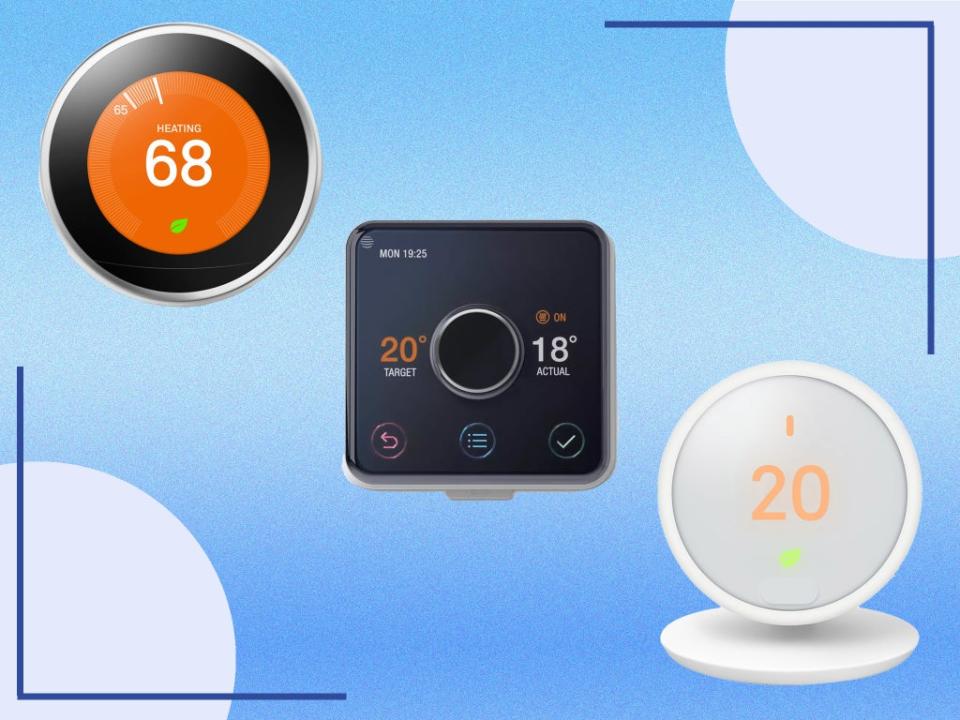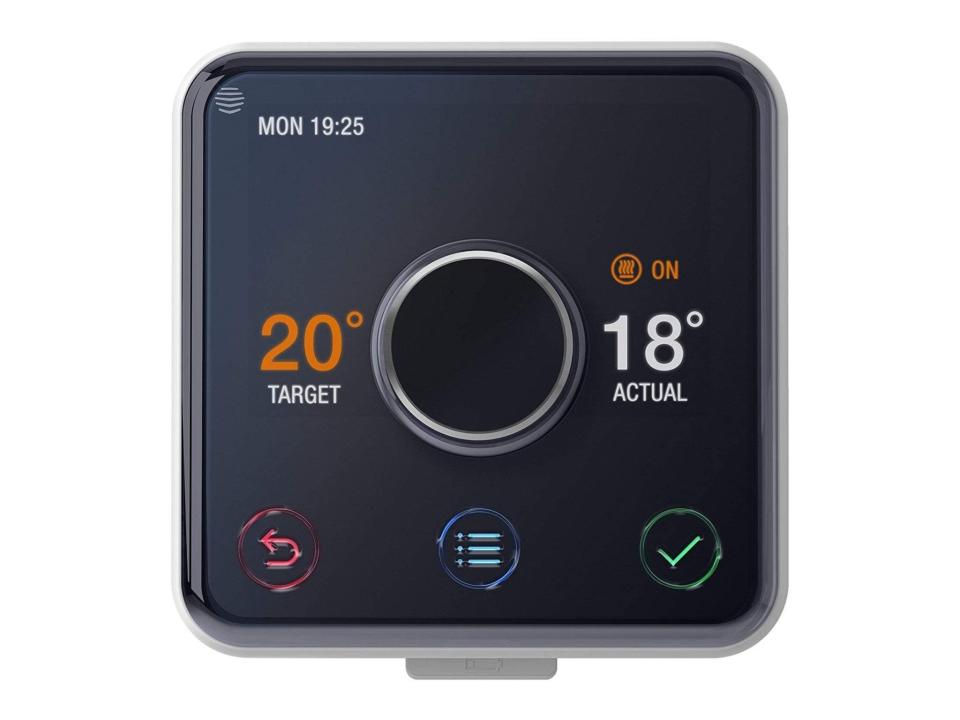5 best smart thermostats to keep your home warm and save you money

Thermostats, on the face of it, sound pretty dull, don’t they? Of course, we need them, but can anyone make them exciting or clever?
Actually, yes. A smart thermostat has a lot of advantages and now that the gas and electricity bills for around 22 million of us are set to increase by £693 per household from April, they’re more important than ever. You can often control it with your voice or through a smartphone app, which might save you a trip downstairs to turn the heating up while you stay warm in bed, for instance.
Better yet, if you’re heading home after a few days away, you can switch the heating on via your smartphone before you begin your journey so you don’t return to a freezing house. In our experience, warming a cold house always takes longer than you think, so it’s best to plan ahead.
Some smart thermostats work in tandem with other smart gadgets, meaning if a smoke alarm detects smoke, it can turn the boiler off at the same time to prevent it making a fire worse. Others work with smart radiator units to control the temperature in each room more precisely.
Then there are those which work in conjunction with your smartphone so that the system knows when everyone’s left the house and can turn the temperature down – no longer will you go away on holiday and realise on day two that you left the heating at full blast.
Read more:
11 best portable heaters to keep you warm and snug this winter
7 best video doorbells for upgrading your home security system
How we tested
We tested a range of smart thermostats for simplicity of set-up and use, flexibility of system and level of features. There were our favourites.
The best smart thermostats for 2022 are:
Best overall – Nest learning thermostat: £219, Google.com
Best for control in multiple areas – Honeywell evohome: £297.85, Amazon.co.uk
Best for simplicity – Tado smart thermostat: £199.99, Tado.com
Best for design – Hive active heating 2: £161.10, Hivehome.com
Best on tighter budgets – Nest thermostat E: £199, Google.com
Nest learning thermostat

Best: Overall
Dimensions: 84mm x 84mm x 30 mm
Sensors: Temperature sensors, humidity sensor, proximity sensor
Nest broke the mould when it released its first smart thermostat – this is the third-generation model. It is the most advanced thermostat available and works well with other Nest products such as the company’s smoke and carbon monoxide detector and home security cameras.
It’s very easy to set up and control, with a schedule set up on the Nest smartphone app. This is sophisticated: choose either that the radiators come on at a set time or that they reach “true radiant”, that is the room is at the desired temperature at a certain time, in which case the boiler will kick in rather earlier.
The Nest learning thermostat can spot when you’re out of the house and turn the heating down or off accordingly. The learning part of the name refers to the fact that the thermostat clocks how you use it and adjusts what it does accordingly, though you can always override this with one button press.
Buy now £219.00, Google.com
Honeywell evohome

Best: For control in multiple areas
Dimensions: 139mm x 100mm x 20mm
Sensors: Temperature sensors
This system comes with two wireless radiator controllers, though it’s also available without them. The benefit is that radiators can be individually controlled, so you don’t have to go round to separate rooms to ensure you get exactly the warmth where you need it. Not only does it mean you’re not heating unoccupied rooms but if one person likes a toasty bedroom and another a cooler one, both can be happy.
While it’s temporarily out of stock, you can still order this system and Amazon will update you with a delivery date.
Buy now £297.85, Amazon.co.uk
Tado smart thermostat

Best: For simplicity
Dimensions: 104mm x 104mm x 20mm
Sensors: Temperature sensors, humidity sensor, ambient light sensor
The Tado has the simplest design of all, but it still looks good. Tado has always built in compatibility with Apple’s HomeKit system, which is not the case with most systems. It means you can control the Tado with your voice, whether you have Google, Alexa or Siri as your virtual assistant. Like the Honeywell, you can add individual radiator thermostats to the mix for greater granular control. However, it doesn’t have the learning feature of the Nest, so it won’t adjust the schedules you set, and setting those schedules took more input than some rivals.
Buy now £199.99, Tado.com
Hive active heating 2

Best: Design
Dimensions: 95.9mm x 95.9mm x 46.2mm (inc. dial)
Sensors: Temperature sensors, humidity sensor, proximity sensor
The Hive thermostat is certainly attractive, so you won’t worry about it being prominently placed. There are other compatible elements in the Hive line-up, such as radiator valves, smart window and door sensors, smart lights, camera, motion sensors and smart plugs, so you can easily expand your smart home beyond your heating when you’re ready.
None of them looks as smart as the thermostat, mind. Like the Nest (£219, Google.com), the Hive can be set to spot when you leave the house and adjust the heating accordingly. Hive is part of British Gas, though you don’t need to be a British Gas customer to get it. Note that you need to add £70 for professional installation, in most cases.
Buy now £161.10, Hivehome.com
Nest thermostat E

Best: On tighter budgets
Dimensions: 390mm x 192mm x 215 mm
Sensors: Temperature sensors, humidity sensor, proximity sensor
This is similar to the Nest learning thermostat above, though you’ll notice that the middle word is absent here: there are no learning capabilities. It’s also not as smart and made of plastic rather than glass and metal. But much of the rest of this thermostat is like its pricier sibling, including a simple push on the screen to make things happen, or operate from a smartphone app. It’s simple and effective – though the pricier one is worth the extra.
Buy now £199.00, Google.com
Smart thermostats FAQs
What to look for in a smart thermostat
Setting them apart from other boiler controllers, smart thermostats have many cost/fuel-saving features. The best ones to look out for include hot water control, multi-room control, the ability to learn your routine, motion sensors, GPS tracking and weather-responsive functionality.
Is it worth getting a smart thermostat?
There are several factors to consider before installing a smart thermostat. If easy control is what you want, then going “smart” with your heating is probably for you. If you don’t already have a boiler controller, you can save money by opting for a smart thermostat by being able to control your heating remotely, see how much you’re using and create different heating zones.
Can you install a smart thermostat yourself?
Many models require professional installation, adding to your overall cost but there are smart thermostats on the market that can be installed by a competent DIYer.
Potential disadvantages to smart thermostats
Among the cons, you may have to pay higher upfront costs or become locked into a brand and its compatible products. The less tech savvy among us might struggle getting used to a smarter system, too.
What is the difference between a smart thermostat and a wifi thermostat?
Unlike smart thermostats, wifi models don’t have the ability to learn from your usage nor the means of programming to automatically change the temperature in your home at a certain time. Smart thermostats can help you save on your bills over time.
The verdict: Smart thermostats
Nest is the standout brand here – its Nest learning thermostat is really excellent: extremely easy to use but full of worthwhile features, and the more affordable Nest thermostat E is also decent. Hive active heating, meanwhile, offers a great-looking thermostat and works as a strong foundation to a smart home if you add other elements later.
Voucher codes
For the latest discounts on heaters and other household appliances, try the links below:
For extra cosiness, snuggle up under one of the best electric blankets that will keep you warm through winter

 Yahoo Finance
Yahoo Finance